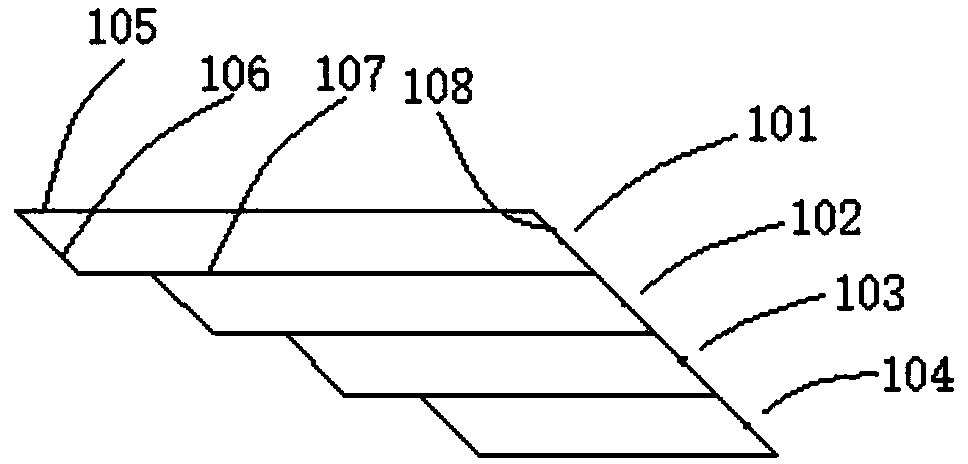Multi-channel parallel light path compression assembly and receiving optical member thereof
A parallel light, multi-channel technology, used in optical components, light guides, optics, etc., can solve problems such as difficulty in mass production, and achieve the effects of small size, easy interchangeability, and high reliability
- Summary
- Abstract
- Description
- Claims
- Application Information
AI Technical Summary
Problems solved by technology
Method used
Image
Examples
Embodiment 1
[0039] Such as figure 1 As shown, the optical path compression assembly provided in this embodiment includes four prisms, namely prism one 101, prism two 102, prism three 103 and prism four 104, and their lengths are L1, L2, L3, L4 respectively. The four prisms All are surrounded by its first working surface 105, second working surface 107, first reflecting surface 106 and second reflecting surface 108 to form a parallelogram, the first working surface 105 is parallel to the second working surface 107, the first working surface 105 is parallel to the second working surface 107, A working surface 105 is perpendicular to the input light, and the incident angle of the input light on the first reflective surface 106 is 45°. Among them, the pitch interval of the input four-channel light wave is P1, the pitch interval of the output four-channel light wave is P2, and the length difference ΔP=P1-P2 of the four prisms, that is, the length of the first prism 101 is L1, and the length of...
Embodiment 2
[0044] Such as image 3 As shown, the optical path compression assembly provided in this embodiment includes four prisms, namely prism one 101, prism two 102, prism three 103 and prism four 104, and their lengths are L1, L2, L3, L4 respectively. The four prisms All are surrounded by its first working surface 105, second working surface 107, first reflecting surface 106 and second reflecting surface 108 to form a parallelogram, the first working surface 105 is parallel to the second working surface 107, the first working surface 105 is parallel to the second working surface 107, A working surface 105 is perpendicular to the input light, and the incident angle of the input light on the first reflective surface 106 is 45°. Wherein, the pitch interval of the input four-channel light wave is P1, and the pitch interval of the output four-channel light wave is P2, then the length of prism one 101 is L1, the length of prism two 102 is L2=L1-(2*P1-P2), and the length of prism three 103...
Embodiment 3
[0048] Such as Figure 5 As shown, the optical path compression component of this embodiment is a variation structure of the optical path compression component of Embodiment 2, the difference lies in the order of the wavelengths of the input beams. Specifically, the optical path compression assembly includes four prisms, namely prism one 101, prism two 102, prism three 103 and prism four 104, the lengths of which are L1, L2, L3, and L4 respectively, and the four prisms are composed of The first working surface 105, the second working surface 107, the first reflecting surface 106 and the second reflecting surface 108 enclose a parallelogram, the first working surface 105 is parallel to the second working surface 107, and the first working surface 105 It is perpendicular to the input light, and the incident angle of the input light on the first reflective surface 106 is 45°. Wherein, the pitch interval of the input four-channel light wave is P1, and the pitch interval of the ou...
PUM
 Login to View More
Login to View More Abstract
Description
Claims
Application Information
 Login to View More
Login to View More - R&D
- Intellectual Property
- Life Sciences
- Materials
- Tech Scout
- Unparalleled Data Quality
- Higher Quality Content
- 60% Fewer Hallucinations
Browse by: Latest US Patents, China's latest patents, Technical Efficacy Thesaurus, Application Domain, Technology Topic, Popular Technical Reports.
© 2025 PatSnap. All rights reserved.Legal|Privacy policy|Modern Slavery Act Transparency Statement|Sitemap|About US| Contact US: help@patsnap.com



